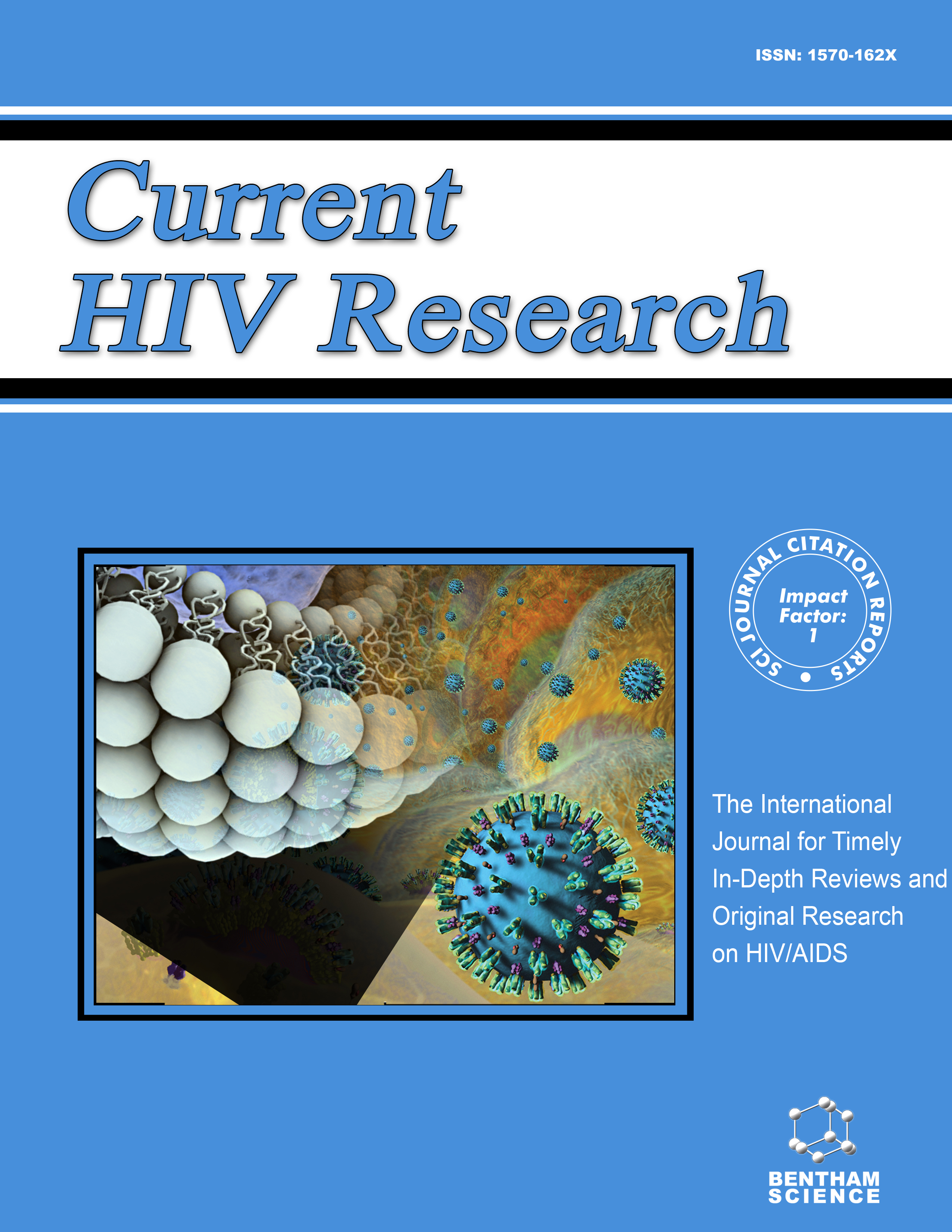- Home
- A-Z Publications
- Current HIV Research
- Previous Issues
- Volume 22, Issue 2, 2024
Current HIV Research - Volume 22, Issue 2, 2024
Volume 22, Issue 2, 2024
-
-
The Hidden Enemy Within: Uncovering the Secrets of HIV Tissues Reservoirs and Current mRNA Vaccine Development
More LessAuthors: Satyendra Prakash and Mayank KumarHuman Immunodeficiency Viruses (HIV) continue to pose a significant global health threat despite the availability of antiretroviral therapy (ART). As a retrovirus, HIV persists as a stable, integrated, and replication-competent provirus within a diverse array of long-lived cells for many years, often termed “latent reservoirs” in individuals. Thus, this review aims to furnish a comprehensive overview of diverse tissue reservoirs where Read More
-
-
-
Discovery of Ten Anti-HIV Hit Compounds and Preliminary Pharmacological Mechanisms Studies
More LessAuthors: Yushan Lian, Zhimin Huang, Xinyi Liu, Zhicheng Deng, Dan Gao and Xiaohui WangBackground: The research and development of HIV drugs is very important, but at the same time it is a long cycle and expensive system project. High-throughput drug screening systems and molecular libraries of potential hit compounds remain the main ways for the discovery of hit compounds with anti-HIV activity. Objective: The aim of this study was to screen out the hit compounds against HIV-1 in the natural prod Read More
-
-
-
Sagittal Abdominal Diameter as the Best Predictor of Metabolic Syndrome in HIV-Infected Men on Antiretroviral Therapy
More LessBackground: The interaction of human immunodeficiency virus (HIV), host and antiretroviral therapy (ART) causes a range of metabolic disorders that can be characterized as a metabolic syndrome (MetS) that increases the cardiovascular risk. MetS involves central obesity, which can be detected using different anthropometric parameters. Objective: To assess the abilities of different anthropometric parameters in the pre Read More
-
-
-
Mortality Risk Factors Among People Living with HIV Receiving Second-line Antiretroviral Therapy in Rural China
More LessAuthors: Qiujia Kang, Wanqi Pan, Yanmin Ma, Dongli Wang, Huangchao Jia, Huijun Guo, Feng Sang, Liran Xu, Qianlei Xu and Yantao JinBackground: Second-line antiretroviral therapy (ART) was introduced in Henan Province in 2009. The number of people living with human immunodeficiency virus (HIV) starting this therapy is increasing. Objective: This study aimed to investigate the survival and factors affecting mortality among this group. Methods: We conducted a retrospective cohort study of people living with HIV (PLHIV) who switched to seco Read More
-
-
-
Heterologous DNA Prime/Protein Boost Immunization Targeting Nef-Tat Fusion Antigen Induces Potent T-cell Activity and in vitro Anti-SCR HIV-1 Effects
More LessAuthors: Leila Sadeghi, Azam Bolhassani, Elham Mohit, Kazem Baesi and Mohammad R. AghasadeghiBackground: Heterologous combinations in vaccine design are an effective approach to promote T cell activity and antiviral effects. The goal of this study was to compare the homologous and heterologous regimens targeting the Nef-Tat fusion antigen to develop a human immunodeficiency virus-1 (HIV-1) therapeutic vaccine candidate. Methods: At first, the DNA and protein constructs harboring HIV-1 Nef and the first exon o Read More
-
-
-
Assessment of Knowledge and Concern of People Living with HIV Regarding Human Mpox and Vaccination
More LessAuthors: Deniz Borcak, Yusuf E. Özdemir, Zuhal Yesilbag, Esra Ensaroğlu, Samiha Akkaya and Kadriye Kart YaşarIntroduction: Mpox virus is an orthopoxvirus that causes the zoonotic infectious disease known as mpox. The disease can also spread from humans to humans. It can be transmitted through contact with bodily fluids, lesions on the skin, or internal mucosal surfaces. Method: The number of mpox cases increased during the COVID-19 pandemic. Early diagnosis and prompt management of mpox are critical in people living with HIV ( Read More
-
-
-
Turkish Translation and Cross-Cultural Validity of WHOQOL-HIV Bref Tool
More LessBackground: The assessment of health-related quality of life among people living with HIV (PLWH) has gained increasing importance as it assesses their overall well-being, guides treatment decisions, and addresses psychosocial challenges, improving their quality of life. This study focuses on adapting and validating the Turkish version of the WHOQOL-HIV Bref, a tool developed by the World Health Organization (WHO) to meas Read More
-
-
-
Outcomes of Total Hip Arthroplasty Performed for HIV-Associated Osteonecrosis in China: A Retrospective Cohort Study
More LessAuthors: Kangpeng Li, Rui Ma, Rugang Zhao and Qiang ZhangBackground: In the post-epidemic era, Acquired Immune Deficiency Syndrome (AIDS) remains one of the most prevalent and detrimental infectious diseases worldwide. The incidence of osteonecrosis of the femoral head (ONFH) in AIDS patients is 100 times higher than that in healthy individuals. Although Total Hip Arthroplasty (THA) is ultimately necessary for most patients, there is still a dearth of evidence regarding its safety and Read More
-
Volumes & issues
-
Volume 22 (2024)
-
Volume 21 (2023)
-
Volume 20 (2022)
-
Volume 19 (2021)
-
Volume 18 (2020)
-
Volume 17 (2019)
-
Volume 16 (2018)
-
Volume 15 (2017)
-
Volume 14 (2016)
-
Volume 13 (2015)
-
Volume 12 (2014)
-
Volume 11 (2013)
-
Volume 10 (2012)
-
Volume 9 (2011)
-
Volume 8 (2010)
-
Volume 7 (2009)
-
Volume 6 (2008)
-
Volume 5 (2007)
-
Volume 4 (2006)
-
Volume 3 (2005)
-
Volume 2 (2004)
-
Volume 1 (2003)
Most Read This Month
Article
content/journals/chr
Journal
10
5
false
en


